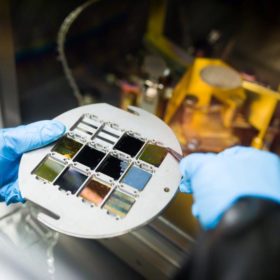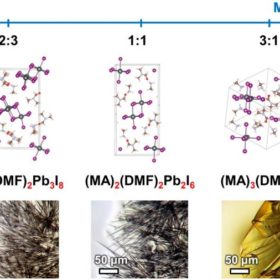Researchers show world-record 20.9% perovskite cell, new SSG process increasing stability
This marks another world record conversion efficiency for perovskite solar cells. A newly developed process reportedly reduces non-radiative recombination of the cells. The new cell is the result of joint research between the England-based Universities of Oxford, Cambridge, Surrey and China-based Beijing.
Momentum builds for perovskite tandems, 25%+ efficiency achieved
Researchers from Helmholtz-Zentrum Berlin (HZB) and Oxford PV have presented a new record perovskite tandem solar cell, with a 25.2% conversion efficiency, independently verified by Fraunhofer ISE. Bernd Stannowski, from HZB presented the results this week at the World Conference on Photovoltaic Energy Conversion (WCPEC-7) in Hawaii.
EPFL produces 25.2% silicon-perovskite tandem, ‘cost competitive’ production claimed
Crystalline silicon tandem cell structures show great promise in delivering efficiencies beyond the limits of conventional c-Si. Swiss researchers claim to have gone beyond 25% with a c-Si-perovskite tandem cell structure, using what they claim is a competitive production process.
Skanska, Saule Technologies to install BIPV perovskite modules on office buildings
The two companies have signed a license agreement. The first pilot projects with the semitransparent perovskite solar cells are planned for this year in Poland
German scientists claim inhomogeneous perovskite films are highly functional
Contrary to common belief, holes in perovskite films may not always negatively affect the performance of perovskite-based solar cells, according to recent research from the Helmholtz Zentrum Berlin (HZB).
EPFL-led research group seeks to stabilize perovskite solar cells with guanidinium
The group of scientists is adopting organic cations, instead of inorganic cations like cesium or rubidium, to stabilize the crystal structures of perovskites with solar applications.
US scientists use hybrid organic–inorganic perovskites to increase solar cell efficiency
Research funded by the US Department of Energy and conducted by the University of Virginia has demonstrated how the rotation of organic molecules in hybrid organic–inorganic perovskites may expand the lifetime of photoexcited charge carriers.
Italian researchers use graphene oxide to increase efficiency of perovskite cells
Scientists of the University of Florence claim that graphene-based electron transport layers (ETL) achieve higher carrier injection with respect to most commonly used ETLs.
Russian scientists study potential of crystalline solvates for increasing efficiency of perovskite cells
Scientists at Moscow, Moscow State University (MSU) have explained how altering the ratio of components forming light absorbing layers of a perovskite solar cell influences the structure of created films and battery efficiency.
Swiss researchers improve stability of perovskite solar cells
EPFL scientists have marginally improved the operational stability of perovskite cells with the introduction of cuprous thiocyanate protected by a thin layer of reduced graphene oxide.









